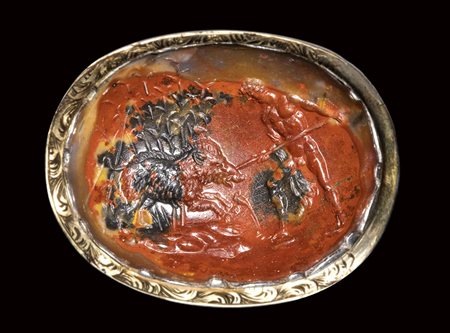 Bertolami Fine Art - Bertolami Fine Art, 1 Harewood Place 1, W1S 1BU Londra
Bertolami Fine Art - Bertolami Fine Art, 1 Harewood Place 1, W1S 1BU Londra
ASTA 107 - Glittica Sessione Unica
venerdì 22 aprile 2022 ore 15:00 (UTC +00:00)
A fine roman moss agate intaglio set in a gilded frame. Meleager kills the boar.<br><br>1st - 2nd A.D.
A fine roman moss agate intaglio set in a gilded frame. Meleager kills the boar.
1st - 2nd A.D.
After an abundant harvest Oineo had offered a sacrifice to all the gods but forgot to honor Artemis, who in retaliation sent a boar of enormous proportions to the lands of Calydon which devastated the fields and killed anyone who came out of the city walls. To kill the animal, the father appealed to many heroes and once gathered the group entrusted them to his son Meleager who started the hunt. Among them also appeared Atalanta, a beautiful huntress who infatuated Meleager. The boar wounded by an arrow is then killed by Meleager with the spear. The scene is inspired by mosaics and by some scenes carved on the marble sarcophagi (Roma, Musei Capitolini; Galleria Doria Pamphili; ). In this extraordinary intaglio, engraved on a large moss agate, a naked youth with a cloack attacks a boar in a cane thicket, with his spear. Rocky ground. The young man is to be identified with Meleager. The hero is naked and wears only a cloak that flutters in the air for his dynamic hunting movement. The legs are well divaricated in the classic pose taken from greek art, and the strong arms mercilessly sink the spear, to kill the beast. The wild boar is large and muscular, characterized by an almost prickly shaggy coat. The naturalism of its rendering makes it expressive and almost alive, both in the movement and in its feral charge. The animal emerges from a cane thicket on a rocky and hostile ground. At the hero's feet, a poppy flower, symbol of the underworld and prelude to his death. The intaglio is performed with great art and technical mastery. The choice of this extraordinary variety of stone matches perfectly with the scene, and the various macules and inclusions symbolize its details. Above, clear cerulean inclusions symbolize the sky, the green inclusions the vegetation, the beautiful red inclusion (similar to jasper) looks like a blood curtain that dyes the killing scene. The edge has small chips, the back a slight crack. The gem has a convex surface, with signs of wear, and is mounted in an old chiseled frame from the 18th / 19th century, likely a central pendant of a necklace. On the back of the metal edge, traces of welding for ancient repairs of the chain rings / hooks, missing. The subject seems to have subsequently inspired a second intaglio but in chalcedony, probably to be attributed to Natter (with variants, for example without the poppy flower). The sources record the existence of another (lost) intaglio in nicolo (broken?) with the same scene. Parallel: AGDS Munchen, vol. 2 n. 880 for the boar with the plants. See also J. Boardman, J. Kagan, C. Wagner, Natter's Museum Britannicum, n. 388 for a very close depiction: "chez Mons. Le comte de Sizdome acheté a Rome, fait en deux, mais rejoint. Gravée dans un nicolo - Meleager tue le sanglier". Once Louis, Duc de Blacas d'Aulps. Cf. Chalcedony intaglio, possibly Natter's copy, Leiden, RMO GS-10369.
Stone 23 x 30 mm, with mounting 26 x 34 mm; 7,67 gr.
















